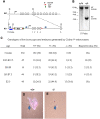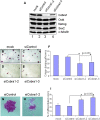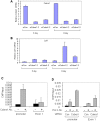Mouse cofactor of BRCA1 (Cobra1) is required for early embryogenesis
- PMID: 19340312
- PMCID: PMC2661135
- DOI: 10.1371/journal.pone.0005034
Mouse cofactor of BRCA1 (Cobra1) is required for early embryogenesis
Abstract
Background: Negative elongation factor (NELF) is a four-subunit protein complex conserved from Drosophila to humans. In vitro biochemical and tissue culture-based studies have demonstrated an important role of NELF in controlling RNA polymerase II (Pol II) pausing in transcription. However, the physiological significance of NELF function is not clear due to the lack of any genetic systems for studying NELF.
Principal findings: Here we show that disruption of the mouse B subunit of NELF (NELF-B), also known as cofactor of BRCA1 (Cobra1), causes inner cell mass (ICM) deficiency and embryonic lethality at the time of implantation. Consistent with the phenotype of the Cobra1 knockout (KO) embryos, knockdown of Cobra1 in mouse embryonic stem cells (ESCs) reduces the efficiency of colony formation and increases spontaneous differentiation. Cobra1-depleted ESCs maintain normal levels of Oct4, Nanog, and Sox2, master regulators of pluripotency in ESCs. However, knockdown of Cobra1 leads to precocious expression of developmental regulators including lymphoid enhancer-binding factor 1 (Lef1). Chromatin immunoprecipitation (ChIP) indicates that Cobra1 binds to the Lef1 promoter and modulates the abundance of promoter-bound RNA polymerase.
Conclusions: Cobra1 is essential for early embryogenesis. Our findings also indicate that Cobra1 helps maintain the undifferentiated state of mESCs by preventing unscheduled expression of developmental genes.
Conflict of interest statement
Figures




References
-
- Surani MA, Hayashi K, Hajkova P. Genetic and epigenetic regulators of pluripotency. Cell. 2007;128:747–762. - PubMed
-
- Loh YH, Wu Q, Chew JL, Vega VB, Zhang W, et al. The Oct4 and Nanog transcription network regulates pluripotency in mouse embryonic stem cells. Nat Genet. 2006;38:431–440. - PubMed
-
- Azuara V, Perry P, Sauer S, Spivakov M, Jørgensen HF, et al. Chromatin signatures of pluripotent cell lines. Nat Cell Biol. 2006;8:532–538. - PubMed
Publication types
MeSH terms
Substances
Grants and funding
LinkOut - more resources
Full Text Sources
Other Literature Sources
Molecular Biology Databases
Research Materials
Miscellaneous

